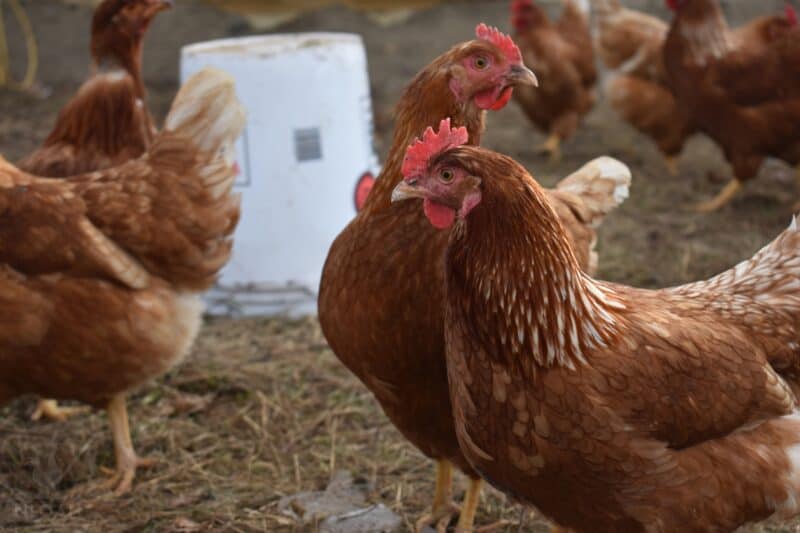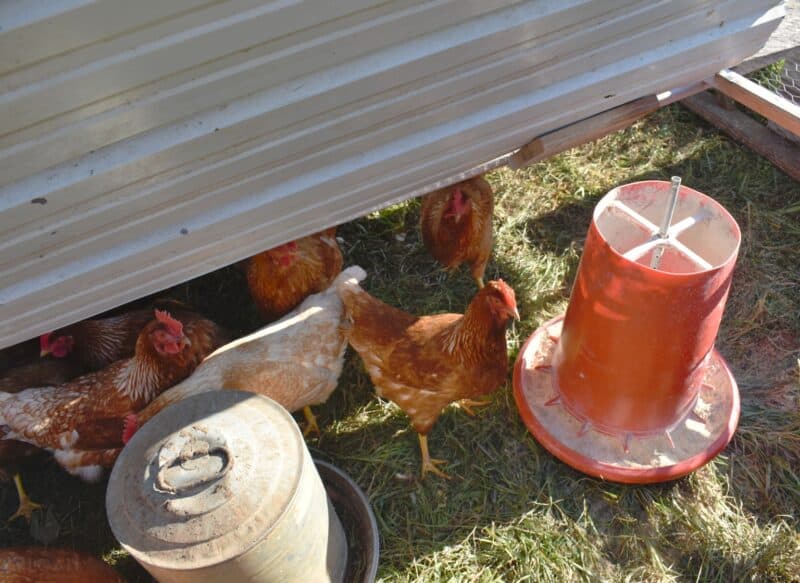The New Hampshire chicken was the first chicken my husband and I decided to raise on our small farm – back when we thought we would “just have a few chickens” for the eggs.
Today, we raise a flock of 75 laying hens along with more than 300 meat birds each summer, as our farm has scaled up and we now meet the demands of several families and a restaurant.

Although we’ve moved away from the New Hampshires as our main breed, we still have a few prized members of our flock that are New Hampshire hens. There’s so much to love about these chickens that I just have a hard time giving up on them!
Not only are they friendly and docile, but they’re also remarkable layers. A phenomenal dual-purpose breed, the New Hampshire chicken is one you really should consider keeping in your backyard flock.
Here’s everything you need to know.
Table of Contents:
New Hampshire Chicken Background
Although the New Hampshire chicken looks a lot like the Rhode Island, the two are actually different breeds.
That said, there are a lot of genetic similarities between the two. This chicken breed is relatively young when it comes to all things chicken, having been developed only around 1910.
A strain of the Rhode Island breed, the New Hampshire was created out of a desire to produce a breed that would grow faster, mature faster, and feather faster than the Rhode Island.
It was created by Professor Red Richardson, who worked in an Agricultural Experimentation Station and used the breed in the popular Chicken of Tomorrow documentaries.
This chicken breed was offered up as a potential answer to the need for additional meat protein during the war years. It could not only produce a ton of eggs, but also enough meat to feed America!
It became one of the first breeds to then be used in what is now the modern broiler industry. New Hampshire roosters are frequently crossed with Barred Rock hens to produce black sex link chicks, while New Hampshire roosters can be crossed over white Plymouth Rock or Rhode Island Whites for red sex link chicks.
As a dual-purpose chicken breed, New Hampshire is ridiculously popular for people who raise backyard chickens, too.
What Do New Hampshire Chickens Look Like?
New Hampshire chickens look a lot like Rhode Island chickens, and as you might guess, are easily confused. The two are about the same size, but New Hampshire has a body shape that is more triangular in nature.
It is deep and broad, with a large, meaty composition. Its feathers are a pale shade of red, much lighter than that of Rhode Island. Occasionally, you will also find New Hampshire chickens with pale yellow highlights, or those that seem to be almost bleached out.
Both the tail feathers and the neck feathers of this bird are tipped with black. Beneath the feathers, you’ll find underfeathers that are a pale pink color.
New Hampshire chickens have single combs that redden as the chickens age. The wattles and ear lobes are also red, while the beak is a reddish horn color. The eyes are orange and the shanks are clean and yellow. The skin, too, is that familiar yellow.
There is a bantam version of this chicken breed but it’s not all that common. These chickens usually only weigh around 30-34 ounces or so, or less than two pounds (900 grams).
That’s a sharp contradiction to the standard version of this chicken breed – the roosters tip the scales at 8 lbs, while hens are usually around six and a half.
There are a few other less common varieties of New Hampshire chickens, too. The blue-tailed New Hampshire, first bred in Holland, is exceedingly rare, as is the New Hampshire White.
In order for the New Hampshire chicken to be classified as a distinct breed from the Rhode Island Red, it is classified by the American Poultry Association as American and was admitted only in 1935 as its own breed.
Behavioral Characteristics of the New Hampshire Chicken
The New Hampshire chicken is known for having many positive behavioral characteristics. These chickens are decent pets (perhaps not the most docile birds you will find, but not the least, either). They are easy to tame as they are very food-motivated.
The only downfall to how easy they are to train with food is that they can sometimes be a bit aggressive around food. They will often shove and push other flock members out of the way.
While this isn’t usually an issue if you are raising a flock composed solely of New Hampshire chickens, it can be problematic if you raise a mixed flock that includes more docile chicken breeds.
An easy way around this is to simply provide separate feeding stations so that every bird has plenty of room to eat and drink.
As with any chicken breed, you’ll find that the personality of your birds varies widely depending on the individual chicken.
New Hampshire chickens tolerate confinement fairly well, but should be given the opportunity to free range – this can prevent issues with boredom in your flock. It can also reduce your feed bill, as New Hampshire chickens are known for being excellent foragers.
They aren’t known for being overly loud, nor are they that flighty. While you will want to build a solid pen to keep your hens contained, you don’t have to erect a super tall fence or worry about them taking to the skies to get away. For the most part, they aren’t easily spooked when you approach them.
Is the New Hampshire Chicken Good for Eggs?
New Hampshire chickens are prized for their ability to lay lots of eggs. You’ll get roughly three to four eggs per bird each week, adding up to about 200 large pale brown eggs each year. Some birds may lay a few more, some a few less.
However, what all New Hampshire chickens have in common is that they tend to lay a bit longer than many hybrid strains of egg-laying chickens.
For example, Golden Comets, popular commercial egg chickens, will stop laying after a couple of years – New Hampshire hens might slow down, but their egg production will continue until they are much older.
New Hampshire chickens are also prized for their tendency to go broody often. They sit well on their own eggs, rarely abandoning them except to occasionally eat and drink. If the eggs are able to hatch, New Hampshire hens make decent mothers, too.

In some cases, you may even be able to hatch eggs from other hens beneath your New Hampshire! Of course, this does vary depending on the bird.
Naturally, your egg production will vary depending on a few other factors, too. For example, the time of year and the age of your hens can impact how many eggs you get – and how often you get them.
Most New Hampshires start laying at around five to seven months of age, but this can be variable depending on their diet, the age at which they hatch, and the weather.
Is the New Hampshire Chicken Good for Meat?
Can’t decide whether you want to raise chickens for meat or for eggs? Don’t worry – with the New Hampshire chicken, you can do both!
This breed is well-known for its versatility as a dual-purpose chicken breed. Many people purchase these chickens as straight run birds to save money from the hatchery. The hens are raised for eggs while the roosters are raised for meat production.
On average, a New Hampshire rooster will mature at around 8 lbs, while hens will be around 6 lbs. That’s the perfect table weight for most families.
Although New Hampshire chickens won’t grow ridiculously large, like some other breeds of chickens that have been raised primarily for their rapid growth rates and sizes, they will do so at a modest and respectable rate.
Many chicken keepers praise the excellent feed conversion rates of these birds -you won’t waste a ton of money on feed because these chickens are such great foragers.
Health Issues of New Hampshire Chickens
New Hampshire chickens, as heritage chickens, tend to be much harder and healthier than many other modern breeds of chickens.
While you’ll want to stay on top of hygiene and basic preventative care to avoid issues like parasites and communicable diseases, for the most part, these chickens aren’t prone to many problems.
They hold up particularly well in extreme weather conditions. Because they were developed in the United States, they can tolerate dramatic swings in temperature with ease (provided that you have adequate housing, of course).
Particularly in the winter, you will want to take some extra steps to make sure that your coop is warm and well-ventilated.
Because New Hampshire chickens have relatively large combs, it is easy for them to become frostbitten here. You can dab a bit of Vaseline on the comb during particularly nippy nights, which should help prevent frostbite from settling in.
Make sure your New Hampshire flock has access to plenty of fresh, clean water and nutritious feed. Give them access to a dust bath and plenty of room to graze around. If you do this, you don’t have to worry about too many issues with parasites and other diseases. They will generally live for around seven years if all else remains the same.
Tips for Raising New Hampshire Chickens
For the most part, raising New Hampshire chickens is not unlike raising chickens of any other breed. You’ll need to make sure you build a decent-sized coop with at least three to four square feet of space per bird, along with plenty of space outdoors for them in the run.
Fill the coop with lots of fresh bedding and ample nesting boxes (at least one for every four birds). As larger chickens, you may find that your New Hampshires require more space than bantam chickens or other smaller breeds, but otherwise, there are no other special considerations you need to make for these birds in the coop or run.
They can be fed a diet of layer or broiler feed (I recommend broiler feed if you are raising a mixed flock that includes both hens and roosters, as excess calcium can lead to kidney problems in the roosters) with occasional treats.

For the most part, you won’t have to provide your New Hampshire chickens with many extra treats – they will find their own treats as they forage about your lawn!
Should I Raise the New Hampshire Chicken?
Ultimately, it’s up to you as you decide whether or not the New Hampshire chicken breed is a good choice for your flock.
These chickens present few disadvantages. They establish a pecking order quickly, and can sometimes be a bit too dominant when it comes to their relationships with the rest of the flock members.
Therefore, if you are planning on introducing New Hampshire chickens to an already-established flock, you may want to exercise some caution in how you do so. Introduce new birds gradually to prevent any issues with bullying.
Because New Hampshire chickens are particularly curious and intelligent, you may find that you have some issues with them wondering wherever they’d like during their daily free-ranging, too.
If you want to keep them out of your garden (or otherwise contained in a specific area), you may need to build a slightly taller fence or consider other methods of control, such as clipping their wings.
As with all dual-purpose breeds of chickens, you’ll face one more disadvantage in raising New Hampshire chickens – and that is that there is a significant trade-off. Although New Hampshires are decent egg layers and decent meat producers, they don’t produce the most amount of eggs or the most amount of meat.
However, if you want the best of both worlds out of your backyard flock, you won’t find a better chicken breed than New Hampshire! I highly recommend this breed to anybody who is just getting started with a backyard flock.

Rebekah is a high-school English teacher n New York, where she lives on a 22 acre homestead. She raises and grows chickens, bees, and veggies such as zucchini (among other things).
